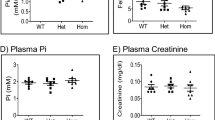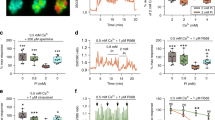Abstract
Defects in the human Ca2+-sensing receptor gene have recently been shown to cause familial hypocalciuric hypercalcaemia and neonatal severe hyperparathyroidism. We now demonstrate that a missense mutation (Glu128Ala) in this gene causes familial hypocalcaemia in affected members of one family. Xenopus oocytes expressing the mutant receptor exhibit a larger increase in inositol 1,4,5-triphosphate in response to Ca2+than oocytes expressing the wild-type receptor. We conclude that this extracellular domain mutation increases the receptor's activity at low Ca2+ concentrations, causing hypocalcaemia in patients heterozygous for such a mutation.
This is a preview of subscription content, access via your institution
Access options
Subscribe to this journal
Receive 12 print issues and online access
$209.00 per year
only $17.42 per issue
Buy this article
- Purchase on Springer Link
- Instant access to full article PDF
Prices may be subject to local taxes which are calculated during checkout
Similar content being viewed by others
References
Brown, E.M., Extracelluar Ca2+ sensing, regulation of parathyroid cell function, and role of Ca2+ and other tons as extracellular (first) messengers. Physiol. Rev. 71, 371–411 (1991).
Brown, E.M. et al. Cloning, expression, and characterization of an extracellular Ca2+-sensing receptor from bovine parathyroid. Nature 366, 575–580 (1993).
Chou, Y.-H.W. et al. The gene responsible for familial hypocalciuric hypercalcemia maps to chromosome 3q in four unrelated families. Nature Genet. 1, 295–299 (1992).
Pollak, M.R. et al. Mutations in the human Ca2+-sensing receptor gene cause familial hypocalciuric hypercalcemia and neonatal severe hyperparathyroidism. Cell 75, 1297–1303 (1993).
Pollak, M.R. et al. Familial hypocalciuric hypercalcemia and neonatal severe hyperparathyroidism: The effects of mutant gene dosage on phenotype. J. clin. Invest. 93, 1108–1112 (1994).
Berridge, M.J. Inositol triphosphate and calcium signalling. Nature 361, 315–325 (1993).
Khosla, S. et al. Calcium infusion suggests a “set-point” abnormality of parathyroid gland function in familial benign hypercalcemia and more complex disturbances in primary hyperparathyroidism. J. clin. Endocrinol. Metab. 76, 715–720 (1993).
Marx, S.J. et al. Secretory dysfunction in parathyroid cells from a neonate with severe primary hyperparathyroidism. J. clin. Endocrinol. Metab. 62, 445–449 (1986).
Leftkowitz, R.J. Turned on to ill effect. Nature 365, 603–604 (1993).
Hunter, A.G.W., Heick, H., Poznanski, W.J. & McLaine, P.N. Autosomal dominant hypoparathyroidism: a proband with concurrent nephrogenic diabetes insipidus. J. Med. Genet. 18, 431–435 (1981).
Ho, K. et al. Cloning and expression of an inwardly rectifying ATP-regulated potassium channel. Nature 362, 31–38 (1993).
Parker, I. & Yao, Y. Relation between intracellular Ca2+-signals and Ca2+-activated CI− current in Xenopus oocytes. Cell Calcium 15, 276–288 (1994).
Parma, J. et al. Somatic mutations in the thyrotropin receptor gene cause hyperfunctioning thyroid adenomas. Nature 65, 649–651 (1993).
Shenker, A. et al. A constitutively activating mutation of the luteinizing hormone receptor in familial male precocious puberty. Nature 653, 652–654 (1993).
Sherwood, L.M. Hypoparathyroidism. in Primer on the metabolic bone diseases and disorders of mineral metabolism (Raven Press, New York, 1993).
Shane, E., Hypocalcaemia: Pathogenesis, differential diagnosis, and management. In Primer on the metabolic bone diseases and disorders of mineral metabolism (Raven Press, New York, (1993).
Ott, J. Analysis of human genetic linkage. (Johns Hopkins University Press, Baltimore, (1991).
Weissenbach, J. et al. A second-generation linkage map of the human genome. Nature 359, 794–801 (1992).
Lathrop, G.M. et al. Strategies for multilocus linkage analysis in humans. Proc. natn. Acad. Sci. U.S.A. 81, 3443–3446 (1984).
Gamba, G. et al. Primary structure and functional expression of a cDNA encoding the thiazide-sensitive, electroneutral sodium-chloride cotransporter. Proc. natn. Acad. Sci. U.S.A. 90, 2749–2753 (1993).
Ausubel, F.M. et al. Current protocols in molecular biology. (Greene Publishing, NewYork.(1989).
Author information
Authors and Affiliations
Rights and permissions
About this article
Cite this article
Pollak, M., Brown, E., Estep, H. et al. Autosomal dominant hypocalcaemia caused by a Ca2+-sensing receptor gene mutation. Nat Genet 8, 303–307 (1994). https://doi.org/10.1038/ng1194-303
Received:
Accepted:
Issue Date:
DOI: https://doi.org/10.1038/ng1194-303
This article is cited by
-
Mechanism of sensitivity modulation in the calcium-sensing receptor via electrostatic tuning
Nature Communications (2022)
-
Association of ITPA gene polymorphisms with adverse effects of AZA/6-MP administration: a systematic review and meta-analysis
The Pharmacogenomics Journal (2022)
-
Cognitive deficits in primary hyperparathyroidism – what we know and what we do not know: A narrative review
Reviews in Endocrine and Metabolic Disorders (2022)
-
Sequencing the CaSR locus in Pakistani stone formers reveals a novel loss-of-function variant atypically associated with nephrolithiasis
BMC Medical Genomics (2021)
-
Functional Analysis of Calcium-Sensing Receptor Variants Identified in Families Provisionally Diagnosed with Familial Hypocalciuric Hypercalcaemia
Calcified Tissue International (2020)



